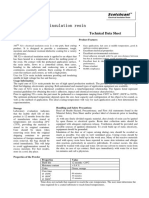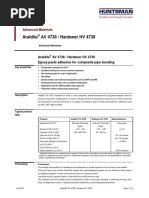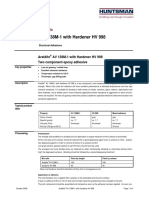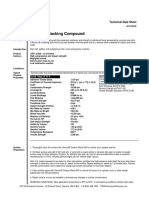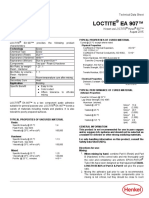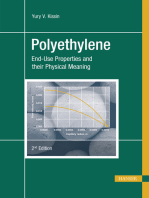Araldite FT 420 AB EN
Araldite FT 420 AB EN
Uploaded by
antoine DelesvauxCopyright:
Available Formats
Araldite FT 420 AB EN
Araldite FT 420 AB EN
Uploaded by
antoine DelesvauxOriginal Title
Copyright
Available Formats
Share this document
Did you find this document useful?
Is this content inappropriate?
Copyright:
Available Formats
Araldite FT 420 AB EN
Araldite FT 420 AB EN
Uploaded by
antoine DelesvauxCopyright:
Available Formats
Advanced Materials
Araldite® 420 A/B
Structural Adhesives
ARALDITE® 420 A/B
Two component epoxy adhesive system
Key properties • Very high lap shear and peel strength
• Bonds a wide variety of materials (metal, composite and thermoplastics)
• Good moisture resistance
• Extremly tough and resilient adhesive
Description ARALDITE® 420 A/B is a two-component room temperature curing, epoxy adhesive paste of high strength and
toughness.Performances can be enhanced by post-curing at elevated temperature. It is suitable for bonding a wide
variety of metals, ceramics and many other substrates in common use.
Product data
Property Araldite 420 A Araldite 420 B Mixed Adhesive
Colour (visual) (A112)* Yellow Blue Dark green
Specific gravity 1.2 1.0 approx. 1.1
Viscosity at 25°C (A93) (Pa.s)* 100-300 0.6-1.4 35-45
Lapshear strength at 23°C (A501)* - - > 30 MPa
Pot Life (100 gm at 25°C) Ca. 60 min
* Specified data are on a regular basis analysed. Data which is described in this document as 'typical' is not
analysed on a regular basis and is given for information purposes only. Data values are not guaranteed or
warranted unless if specifically mentioned.
Processing Pretreatment
The strength and durability of a bonded joint are dependent on proper treatment of the surfaces to be bonded.
At the very least, joint surfaces should be cleaned with a good degreasing agent such as acetone, iso-propanol (for
plastics) or other proprietary degreasing agents in order to remove all traces of oil, grease and dirt.
Low grade alcohol, gasoline (petrol) or paint thinners should never be used.
The strongest and most durable joints are obtained by either mechanically abrading or chemically etching (“pickling”)
the degreased surfaces. Abrading should be followed by a second degreasing treatment
Mix ratio Parts by weight Parts by volume
Araldite 420 A 100 100
Araldite 420 B 40 50
The resin and hardener should be blended until they form a homogeneous mix.
Araldite® 420 A/B is available in cartridges incorporating mixers and can be applied as ready to use adhesive with
the aid of the tool recommended by Huntsman Advanced Materials
.
August 2012 ARALDITE® 420 A/B Page 1 of 6
Application of adhesive
The resin/hardener mix is applied with a spatula, to the pretreated and dry joint surfaces.
A layer of adhesive 0.05 to 0.10 mm thick will normally impart the greatest lap shear strength to the joint.
The joint components should be assembled and clamped as soon as the adhesive has been applied. An even
contact pressure throughout the joint area will ensure optimum cure.
Mechanical processing
Specialist firms have developed metering, mixing and spreading equipment that enables the bulk processing of
adhesive.
We will be pleased to advise customers on the choice of equipment for their particular needs.
Equipment maintenance
All tools should be cleaned with hot water and soap before adhesives residues have had time to cure. The removal of
cured residues is a difficult and time-consuming operation.
If solvents such as acetone are used for cleaning, operatives should take the appropriate precautions and, in addition,
avoid skin and eye contact.
Typical times to minimum shear strength
Temperature °C 23 40 60 100
Cure time to reach hours 7.5
2
LSS > 1N/mm minutes 100 35 <5
Cure time to reach hours 11 2 1
LSS > 10N/mm2 minutes 20
LSS = Lap shear strength.
Typical cured Unless otherwise stated, the figures given below were all determined by testing standard specimens made by lap-
properties jointing 114 x 25 x 1.6 mm strips of aluminium alloy. The joint area was 12.5 x 25 mm in each case.
The figures were determined with typical production batches using standard testing methods. They are provided solely
as technical information and do not constitute a product specification.
Note: The data in this edition is based on recent retesting of the product.
August 2012 ARALDITE® 420 A/B Page 2 of 6
Average lap shear strengths of typical metal-to-metal joints (ISO 4587) (typical average value)
Cured for 16 hours at 40°C and tested at 23°C
Pretreatment - Sand blasting
Aluminium
Steel 37/11
Stainless steel V4A
Galvanised steel
Copper
Brass
N/mm 2 0 5 10 15 20 25 30
Average lap shear strengths of typical plastic-to-plastic joints (ISO 4587) (typical average value)
Cured for 16 hour at 40°C and tested at 23°C. Pretreatment - Lightly abrade and alcohol degrease.
CFRP
EP-GRP
UP-GRP
SMC
ABS
PA
PC
PMMA
PVC
2
N/mm 0 5 10 15 20 25 30 35 40
Lap shear strength versus temperature (ISO 4587) (typical average values)
A: Cure: 4 hours at 50°C B: cure: 7 days at RT
2
N/mm
50 A
40
30 B
20
10
0
°C -55 0 22 40 60 80
August 2012 ARALDITE® 420 A/B Page 3 of 6
Glass transition temperature (ISO 6721) (typical average value)
Cure: 16 hours at 40°C 56°C by DMA
Lap shear strength versus immersion in various media (typical average values)
Unless otherwise stated, L.S.S. was determined after immersion for 30,60 and 90 days at 23°C
30 days 60 days 90 days Cure: 16 hrs at 40°C
As-made value
IMS
Fuel (unleaded)
Ethyl acetate
Acetic acid, 10%
Xylene
Lubricating oil
Paraffin
Water at 23°C
Water at 60°C
Water at 90°C
2
N/mm 0 5 10 15 20 25 30 35 40
Tensile strength at 23°C (ISO 527) (typical average value) 29 MPa
E-modulus 1495 MPa
Elongation at break 4.6 %
Shore Hardness (D scale) (ISO 868/03) (typical average value)
Cure 16 hours/ 40ºC , tested at 23ºC, 75 D
50%RH
Shear modulus G’(ISO 6721) (typical average value)
Cure: 16 hours/ 40°C
-20°C - 1.00 GPa
0°C - 880 MPa
23°C - 730 MPa
60°C - 74 MPa
90°C - 5.5 MPa
August 2012 ARALDITE® 420 A/B Page 4 of 6
Storage ARALDITE® 420A and Araldite® 420 B may be stored at room temperature provided the components are stored in
sealed containers. The expiry date is indicated on the label.
Handling Caution
precautions Our products are generally quite harmless to handle provided that certain precautions normally taken when handling
chemicals are observed. The uncured materials must not, for instance, be allowed to come into contact with
foodstuffs or food utensils, and measures should be taken to prevent the uncured materials from coming in contact
with the skin, since people with particularly sensitive skin may be affected. The wearing of impervious rubber or
plastic gloves will normally be necessary; likewise the use of eye protection. The skin should be thoroughly cleansed
at the end of each working period by washing with soap and warm water. The use of solvents is to be avoided.
Disposable paper - not cloth towels - should be used to dry the skin. Adequate ventilation of the working area is
recommended. These precautions are described in greater detail in the Material Safety Data sheets for the individual
products and should be referred to for fuller information.
Huntsman Advanced Materials warrants only that its products meet the specifications agreed with the user. Specified data are
analysed on a regular basis. Data which is described in this document as 'typical' or 'guideline' is not analysed on a regular basis
and is given for information purposes only. Data values are not guaranteed or warranted unless if specifically mentioned.
The manufacture of materials is the subject of granted patents and patent applications; freedom to operate patented processes is
not implied by this publication.
While all the information and recommendations in this publication are, to the best of Huntsman Advanced Material’s knowledge,
information and belief, accurate at the date of publication, nothing herein is to be construed as a warranty, whether express or
implied, including but without limitation, as to merchantability or fitness for a particular purpose. In all cases, it is the
responsibility of the user to determine the applicability of such information and recommendations and the suitability of
any product for its own particular purpose.
The behaviour of the products referred to in this publication in manufacturing processes and their suitability in any given end-use
environment are dependent upon various conditions such as chemical compatibility, temperature, and other variables, which are
not known to Huntsman Advanced Materials. It is the responsibility of the user to evaluate the manufacturing circumstances and
the final product under actual end-use requirements and to adequately advise and warn purchasers and users thereof.
Products may be toxic and require special precautions in handling. The user should obtain Safety Data Sheets from Huntsman
Advanced Materials containing detailed information on toxicity, together with proper shipping, handling and storage procedures,
and should comply with all applicable safety and environmental standards.
Hazards, toxicity and behaviour of the products may differ when used with other materials and are dependent on manufacturing
circumstances or other processes. Such hazards, toxicity and behaviour should be determined by the user and made known to
Huntsman Advanced Materials handlers, processors and end users.
(Switzerland) GmbH Except where explicitly agreed otherwise, the sale of products referred to in this publication is subject to the general terms and
Klybeckstrasse 200 conditions of sale of Huntsman Advanced Materials LLC or of its affiliated companies including without limitation, Huntsman
4057 Basel
Advanced Materials (Europe) BVBA, Huntsman Advanced Materials Americas Inc., Huntsman Advanced Materials (UAE) FZE,
Switzerland
Huntsman Advanced Materials (Guangdong) Company Limited, and Huntsman Advanced Materials (Hong Kong) Ltd.
Tel: +41 (0)61 299 11 11 Huntsman Advanced Materials is an international business unit of Huntsman Corporation. Huntsman Advanced Materials trades
Fax: +41 (0)61 299 11 12
through Huntsman affiliated companies in different countries including but not limited to Huntsman Advanced Materials LLC in the
www.huntsman.com/advanced_materials USA and Huntsman Advanced Materials (Europe) BVBA in Europe.
Email: advanced_materials@huntsman.com
All trademarks mentioned are either property of or licensed to Huntsman Corporation or an affiliate thereof in one or more, but not
all, countries.
Copyright © 2012 Huntsman Corporation or an affiliate thereof. All rights reserved
August 2012 ARALDITE® 420 A/B Page 5 of 6
You might also like
- 521+technical Data Sheet V-6Document2 pages521+technical Data Sheet V-6TeenTeen GaMingNo ratings yet
- Araldite 2015: Advanced MaterialsDocument6 pagesAraldite 2015: Advanced MaterialsFilipe Alberto MagalhaesNo ratings yet
- Dow Corning 993 Product InfoDocument4 pagesDow Corning 993 Product InfoLloyd R. PonceNo ratings yet
- Jet Marine Grease - TdsDocument2 pagesJet Marine Grease - TdsantonyNo ratings yet
- Exfoliative Cytology PatDocument29 pagesExfoliative Cytology PatAly Bint Smbs100% (1)
- The Bates Method Natural VisionDocument2 pagesThe Bates Method Natural Visiondahlia100% (7)
- 415hoja-tecnica-Araldite 2031-1_eur_eDocument6 pages415hoja-tecnica-Araldite 2031-1_eur_ecristhoffer leytonNo ratings yet
- Araldite 2014-2: Advanced MaterialsDocument6 pagesAraldite 2014-2: Advanced MaterialsAnonymous r3MoX2ZMTNo ratings yet
- Araldite-2014-2 Eur eDocument6 pagesAraldite-2014-2 Eur eguillermoNo ratings yet
- Araldite 2022-1Document5 pagesAraldite 2022-1OtecnicaNo ratings yet
- Advanced Materials Araldite AV 4738 HardDocument5 pagesAdvanced Materials Araldite AV 4738 HardAnup RaiNo ratings yet
- Araldite-2051 TDS-engDocument7 pagesAraldite-2051 TDS-engMatijaNo ratings yet
- Araldit-STANDARD Datasheet PDFDocument3 pagesAraldit-STANDARD Datasheet PDFsiva shanmugamNo ratings yet
- Araldite TDSDocument6 pagesAraldite TDSAwaneesh ShuklaNo ratings yet
- Araldite AV 138M-1 With Hardener HV 998: Advanced MaterialsDocument4 pagesAraldite AV 138M-1 With Hardener HV 998: Advanced MaterialsMajid TorabiNo ratings yet
- COLLANTE FCB 130 - Araldite - FT - AV138M-1 - HV998 - ENDocument4 pagesCOLLANTE FCB 130 - Araldite - FT - AV138M-1 - HV998 - ENMax SalogniNo ratings yet
- Araldite 2053-05 eur_eDocument7 pagesAraldite 2053-05 eur_eMatijaNo ratings yet
- Two Component Clear Epoxy Adhesive: Araldite CrystalDocument3 pagesTwo Component Clear Epoxy Adhesive: Araldite CrystalreinpolyNo ratings yet
- Araldite Standard PDFDocument3 pagesAraldite Standard PDFGRAVYMATRIX VENTURESNo ratings yet
- Araldite SteelDocument3 pagesAraldite Steelsraghunadh123321No ratings yet
- TDS Anabond MS 711Document4 pagesTDS Anabond MS 711saineindiaNo ratings yet
- Araldite 3112 US eDocument4 pagesAraldite 3112 US ebinodNo ratings yet
- Epofine 221 - Finehard 964 - Accelerator 070Document4 pagesEpofine 221 - Finehard 964 - Accelerator 070Karishma PrabhuNo ratings yet
- Anabond 652c Heat Sink Compound Thermally ConductiveDocument2 pagesAnabond 652c Heat Sink Compound Thermally ConductiveRohit MahaleNo ratings yet
- Technical Data Sheet: Silcoset 151 1 Part Adhesive SealantDocument2 pagesTechnical Data Sheet: Silcoset 151 1 Part Adhesive SealantArun VaideeswaranNo ratings yet
- Scotch-Weld: Epoxy AdhesiveDocument6 pagesScotch-Weld: Epoxy AdhesiveJun Bryan Ramirez AbangNo ratings yet
- 62 0918 Dowsil 993 Structural GlazingDocument4 pages62 0918 Dowsil 993 Structural GlazingJozsef LukaNo ratings yet
- Araldite 2011Document2 pagesAraldite 2011nrd9771No ratings yet
- Araldite 2011 Structural Adhesive: Advanced MaterialsDocument6 pagesAraldite 2011 Structural Adhesive: Advanced MaterialsrezaeibehrouzNo ratings yet
- TDS Anabond SM666 June 2021Document3 pagesTDS Anabond SM666 June 2021saineindiaNo ratings yet
- MG Chemicals MARKERSDocument6 pagesMG Chemicals MARKERSMantasPuskoriusNo ratings yet
- Folheto Tecnico - Molykote 7400 Anti-Friction Coating 71-0073E-01Document2 pagesFolheto Tecnico - Molykote 7400 Anti-Friction Coating 71-0073E-01marcosNo ratings yet
- High Performance Backing Compound: Technical Data SheetDocument2 pagesHigh Performance Backing Compound: Technical Data SheetNiku SamarthNo ratings yet
- Brushable Ceramic Blue Red v4Document2 pagesBrushable Ceramic Blue Red v4abhishek raviNo ratings yet
- Epofine 6071A80/ Finecure 197/ Finecure 190/ Finehard 986/ Accelerator 062 Toughened PrepregDocument5 pagesEpofine 6071A80/ Finecure 197/ Finecure 190/ Finehard 986/ Accelerator 062 Toughened PrepregKarishma PrabhuNo ratings yet
- Epofine 184-Finehard 907 - Acc 062Document4 pagesEpofine 184-Finehard 907 - Acc 062Karishma PrabhuNo ratings yet
- Epofine 556 FR/ FInehard 951Document3 pagesEpofine 556 FR/ FInehard 951Karishma Prabhu100% (1)
- 993 STRL Glazing Sealant-Product InfoDocument4 pages993 STRL Glazing Sealant-Product InfocurlyjockeyNo ratings yet
- anabond-412-bearing-retainerDocument3 pagesanabond-412-bearing-retainerKhalandar DaduNo ratings yet
- Epofine 404 - Finehard 2404Document3 pagesEpofine 404 - Finehard 2404Karishma PrabhuNo ratings yet
- F F O P L: Epofine - 740 / Finehard - 918 / Accelerator - 062Document4 pagesF F O P L: Epofine - 740 / Finehard - 918 / Accelerator - 062Karishma Prabhu100% (1)
- 4C20_TDSDocument2 pages4C20_TDSsumitNo ratings yet
- Carboguard 635 Thinned 50% - Sealer PDSDocument5 pagesCarboguard 635 Thinned 50% - Sealer PDSjakeNo ratings yet
- Loctite 380 Black - Ficha TecnicaDocument3 pagesLoctite 380 Black - Ficha TecnicamonsepackNo ratings yet
- Loctite EA 907™: Technical Data SheetDocument2 pagesLoctite EA 907™: Technical Data Sheetuzzy2No ratings yet
- 1 Mil Clear Polyester ESD-Safe Tape: Single Coated Linered TapesDocument3 pages1 Mil Clear Polyester ESD-Safe Tape: Single Coated Linered TapesKelly EnglotNo ratings yet
- Technical Data Sheet Product 406: Worldwide Version, February 1996Document3 pagesTechnical Data Sheet Product 406: Worldwide Version, February 1996Muhammad irtizaNo ratings yet
- LOCA Momentive SN3001_engDocument4 pagesLOCA Momentive SN3001_engRicardo ReisNo ratings yet
- Loctite Nordbak Wear Resistant Putty: Product Description MixedDocument3 pagesLoctite Nordbak Wear Resistant Putty: Product Description MixedFurqan ShabbirNo ratings yet
- Anabond 666t Max Gasket SealantDocument3 pagesAnabond 666t Max Gasket SealantDinesh SaravanaNo ratings yet
- Epofine 4859 - Finehard 4859Document3 pagesEpofine 4859 - Finehard 4859Karishma PrabhuNo ratings yet
- PO - Lapox Metalam BDocument2 pagesPO - Lapox Metalam Bcherukuri.sriramNo ratings yet
- Product Data Sheet: Akzonobel Powder CoatingsDocument3 pagesProduct Data Sheet: Akzonobel Powder CoatingsFerhat ÖzcanNo ratings yet
- Scotchweld EC 2216BADocument8 pagesScotchweld EC 2216BAbenNo ratings yet
- Anabond 124 TDSDocument3 pagesAnabond 124 TDSAbhishekNo ratings yet
- Durostone PCB Solder eDocument6 pagesDurostone PCB Solder eaisyahhamidNo ratings yet
- MOLYKOTE BR2 Plus Grease 80-3104A-01Document2 pagesMOLYKOTE BR2 Plus Grease 80-3104A-01Sophia RoseNo ratings yet
- TDS Tremco CPG APAC SG556Document3 pagesTDS Tremco CPG APAC SG556ahmadbardawilkamalNo ratings yet
- EfekDocument2 pagesEfekGasa RafliNo ratings yet
- Devcon Ma 305 HVDocument2 pagesDevcon Ma 305 HVginger.tsaiNo ratings yet
- Advances in Solid Oxide Fuel Cells and Electronic CeramicsFrom EverandAdvances in Solid Oxide Fuel Cells and Electronic CeramicsNo ratings yet
- FEMA Acronyms, Abbreviations, and Terms (FAAT) List 2005 PDFDocument160 pagesFEMA Acronyms, Abbreviations, and Terms (FAAT) List 2005 PDFlavrik100% (1)
- Role of Bone Screw (Izc & BSS) in Skeletal Anchorage System - A Review ArticleDocument5 pagesRole of Bone Screw (Izc & BSS) in Skeletal Anchorage System - A Review ArticleAlvaro ChacónNo ratings yet
- Abacus 5000 5 Easy Steps PDFDocument26 pagesAbacus 5000 5 Easy Steps PDFshethNo ratings yet
- AcknowledgementDocument13 pagesAcknowledgementVipul TripathiNo ratings yet
- Admit CardDocument2 pagesAdmit Cardraghuram8595No ratings yet
- Module Mounting StructureDocument4 pagesModule Mounting Structureer.rkc91No ratings yet
- CLUB MEDICA Practice Set 2 1Document38 pagesCLUB MEDICA Practice Set 2 1Pauline BiancaNo ratings yet
- Andrew 4.6m C-Ku AntennaDocument2 pagesAndrew 4.6m C-Ku AntennaEng Simon Peter NsoziNo ratings yet
- Chapter 2: CRISIS MANAGEMENT LANDSCAPEDocument23 pagesChapter 2: CRISIS MANAGEMENT LANDSCAPEIRONA STA. ANANo ratings yet
- Lab Force Interactive PDFDocument3 pagesLab Force Interactive PDFPaul Fang100% (1)
- Group AB2 NaturalBlendsDocument22 pagesGroup AB2 NaturalBlendsHarshit Bhattaram100% (2)
- 2023 UA Paper Solved by HannanDocument47 pages2023 UA Paper Solved by HannanHannan syedNo ratings yet
- Fashion ForecastingDocument33 pagesFashion ForecastingBhaswati PandaNo ratings yet
- 2.natural NaomaterialsDocument2 pages2.natural NaomaterialsNandhini NandhiniNo ratings yet
- System Architecture Modeling For Electronic Systems Using MathWorks System Composer and SimulinkDocument10 pagesSystem Architecture Modeling For Electronic Systems Using MathWorks System Composer and Simulinktinkergr25No ratings yet
- Storytelling StrategiesDocument17 pagesStorytelling Strategieschristian b. dellotaNo ratings yet
- Research Proposal of Himalayan Bank Limited For BBS 4th YearDocument12 pagesResearch Proposal of Himalayan Bank Limited For BBS 4th Yearkhadkashishir163No ratings yet
- Multilateral Institutions and PoliciesDocument16 pagesMultilateral Institutions and PoliciestesfaNo ratings yet
- Microsoft Word AADE 03 NTCE 38Document1 pageMicrosoft Word AADE 03 NTCE 38U.s. Ezhil ArivudainambiNo ratings yet
- Automobile Battery Monitoring System Using Arduino Uno R3 Microcontroller BoardDocument14 pagesAutomobile Battery Monitoring System Using Arduino Uno R3 Microcontroller BoardMihai BogdanNo ratings yet
- Ubd Template Story Elements UnitDocument3 pagesUbd Template Story Elements Unitapi-525488543No ratings yet
- Misindia Cosamb (F)Document28 pagesMisindia Cosamb (F)Suman KumarNo ratings yet
- Presented By,: Ravi Kiran K.B 2016602009 Ss&AcDocument20 pagesPresented By,: Ravi Kiran K.B 2016602009 Ss&AcSai BharathNo ratings yet
- Universal ING - LA.Boschi Plants Private LimitedDocument23 pagesUniversal ING - LA.Boschi Plants Private LimitedAlvaro Mendoza MaytaNo ratings yet
- LTM Lesson Plan - Observation 1Document3 pagesLTM Lesson Plan - Observation 1api-267744702No ratings yet
- Wein Bridge OscillatorDocument11 pagesWein Bridge OscillatorDimas Rio100% (1)
- Senior ResumeDocument1 pageSenior Resumeapi-294432721No ratings yet
